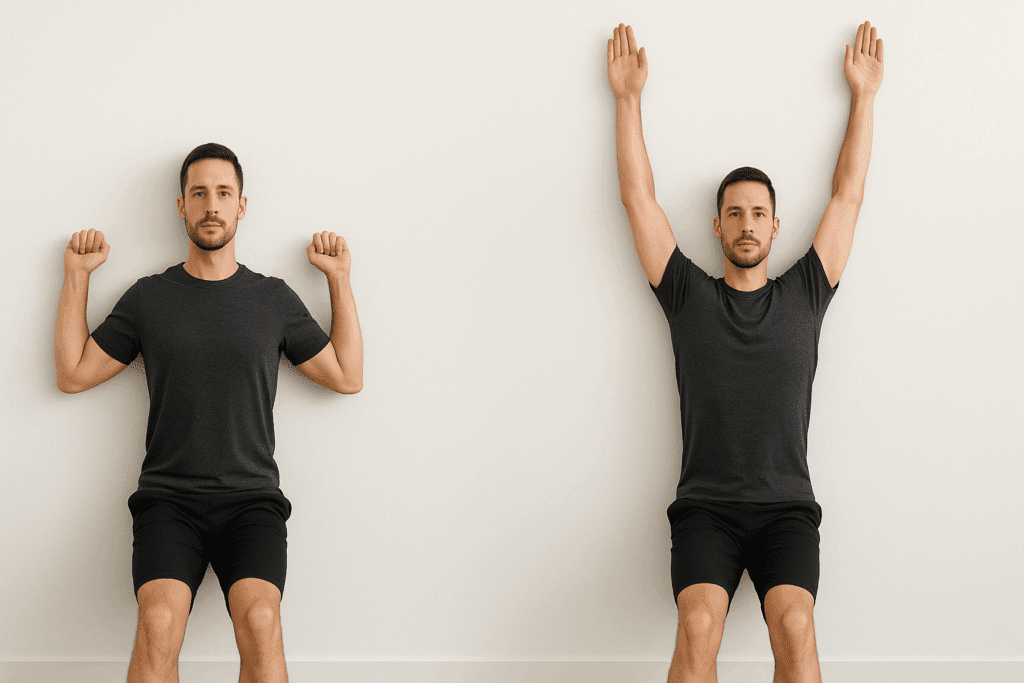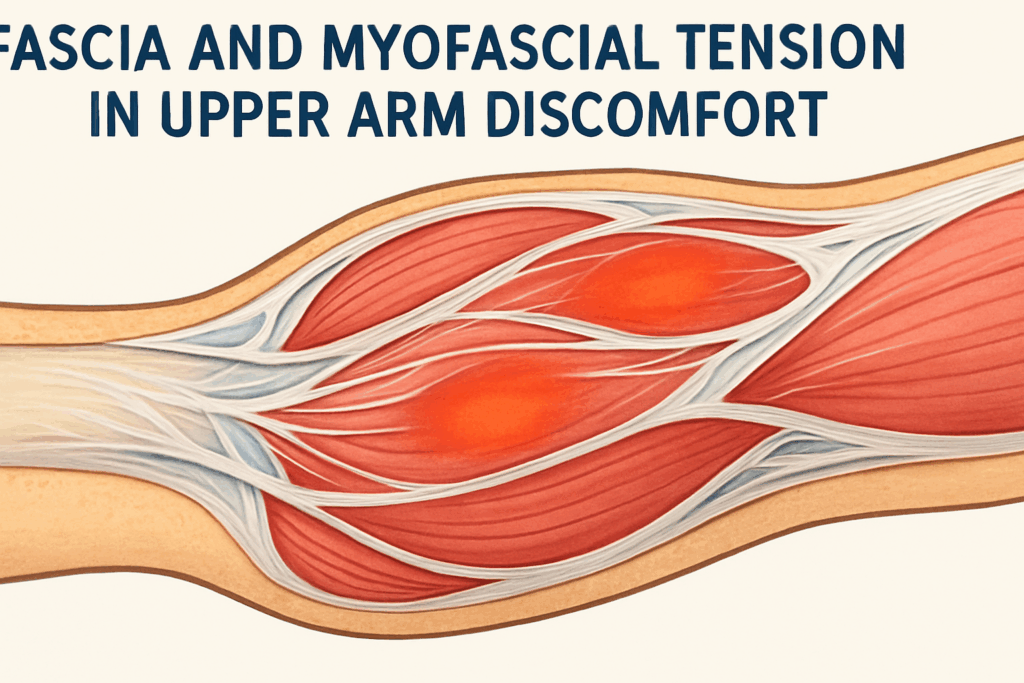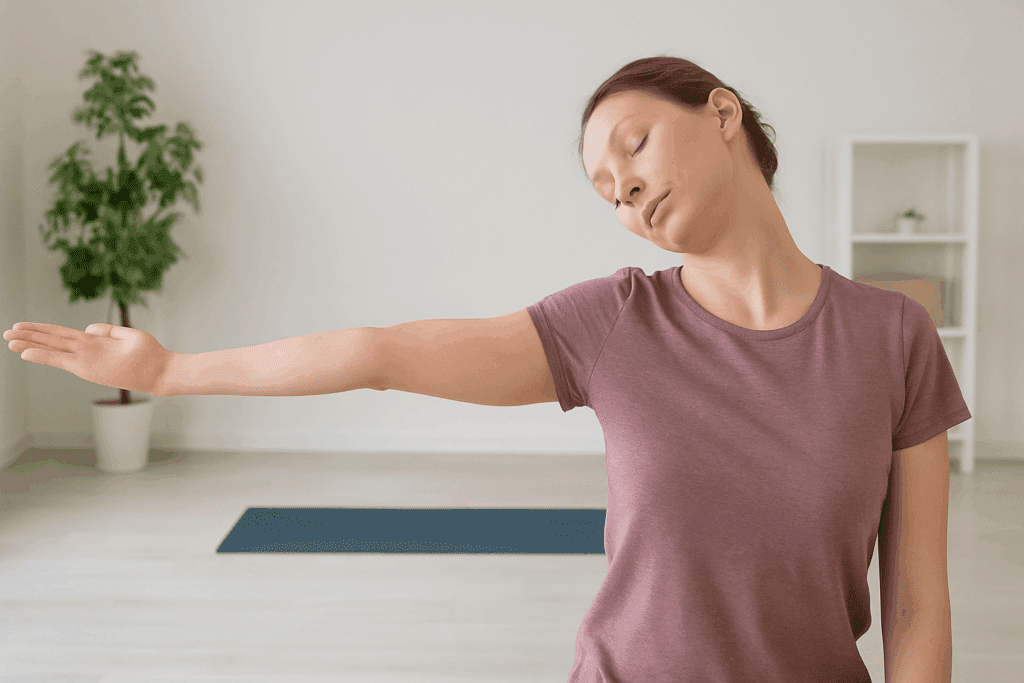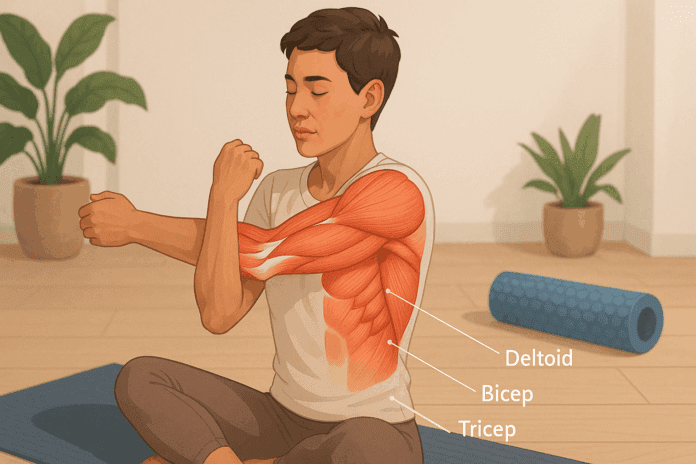Understanding Upper Arm Pain: Causes and Concerns
Upper arm pain can be an unsettling and frustrating experience, often affecting daily activities such as lifting, reaching, or even sleeping comfortably. While this discomfort is commonly linked to overuse injuries, poor posture, or muscular imbalances, it can also stem from deeper issues such as tendonitis, nerve impingement, or rotator cuff strain. For many, this pain does not originate from one specific traumatic event but rather develops gradually due to repetitive movements or prolonged static postures, particularly those involving computer or mobile device use. This means that upper arm discomfort is often preventable and manageable when recognized early and treated with appropriate stretching and strengthening exercises.
You may also like : Best Stretches for Sore Legs and Tight Thigh Muscles: How to Relieve Upper Leg Pain Safely and Naturally
Understanding the anatomy of the upper arm is essential in addressing these issues effectively. The upper arm is composed primarily of the biceps brachii, triceps brachii, and the deltoid muscles, each of which plays a significant role in arm and shoulder mobility. Surrounding structures such as tendons, ligaments, and nerves contribute to the functional complexity of this region. When any component of this system becomes tight or inflamed, it can lead to a cascade of muscular compensation and postural dysfunction. In these instances, stretching exercises for upper arm pain can be a powerful tool not only for symptom relief but also for long-term prevention of chronic issues.

The Role of Stretching in Relieving Upper Arm Pain
Stretching exercises for arm pain are more than just temporary fixes—they are fundamental for restoring muscular balance, enhancing circulation, and promoting long-term recovery. By gently elongating tight arm muscles, these movements improve flexibility, reduce muscle stiffness, and alleviate tension that contributes to discomfort. Additionally, regular stretching can help recondition the arm and shoulder to handle daily tasks with greater ease and resilience.
Physiologically, stretching promotes the lengthening of muscle fibers and the expansion of fascia, the connective tissue surrounding muscles. This not only reduces localized tension in the biceps and triceps but also allows the shoulder joint to move more freely. In cases of impingement or inflammation, strategic stretching can help open compressed areas, providing much-needed relief from nerve or tendon irritation. Moreover, when stretching exercises for upper arm pain are paired with breathing techniques and proper posture, the benefits are compounded, allowing for more effective and sustainable pain management.
Many individuals seek exercises for sore upper arm muscles without realizing that consistent stretching, when done correctly, can help address the root cause of the problem rather than just the symptoms. Importantly, this process must be gradual and tailored to the individual’s specific limitations and capabilities to avoid exacerbating the issue.
Expert Tips for Safe and Effective Stretching
Before diving into a targeted arm pain workout, it’s crucial to understand a few best practices to ensure safety and efficacy. First and foremost, always warm up the body before engaging in deep stretches. Gentle arm circles, shoulder rolls, or a brisk five-minute walk can help raise the body’s core temperature, increase blood flow, and prepare the muscles for elongation.
One of the most critical aspects of effective stretching is awareness—knowing when a stretch is productive versus when it becomes potentially harmful. A good rule of thumb is to stretch to the point of mild discomfort, never sharp pain. Pain is the body’s way of signaling that tissue may be under too much strain, and ignoring it can lead to microtears or worsening inflammation. Therefore, when performing stretching exercises for arm pain, attention to sensation is key.
Another essential tip is to focus on breath. Deep, controlled breathing enhances the relaxation response of muscles, allowing for a more complete and beneficial stretch. Holding each stretch for at least 20 to 30 seconds is generally recommended to allow the muscle fibers enough time to respond. Lastly, consistency is vital. Sporadic stretching will yield minimal results, whereas incorporating a stretching routine into daily or weekly habits can significantly improve outcomes for those dealing with tight arm muscles or upper arm pain.
Shoulder Extension Stretch for Biceps Relief
The shoulder extension stretch is a simple yet effective exercise for upper arm pain that primarily targets the biceps and the front of the shoulder. This stretch is especially beneficial for individuals who spend long hours with their arms in a forward-flexed position, such as typing at a desk or holding a mobile device.
To perform this stretch, stand with your feet shoulder-width apart and clasp your hands behind your back, palms facing each other. Gently straighten your arms and lift your hands away from your back while keeping your chest open and shoulders down. You should feel a stretch across the front of your upper arms and shoulders. If clasping your hands is difficult, you can use a towel or resistance band to bridge the gap. Hold this stretch for 30 seconds and repeat two to three times, gradually deepening the stretch with each repetition.
This movement serves as an excellent starting point for anyone seeking stretching exercises for upper arm pain, particularly those with tight biceps due to prolonged arm flexion. It also encourages proper posture, opening the chest and helping to counteract forward shoulder rounding, which often contributes to upper arm and shoulder discomfort.

Overhead Triceps Stretch for Posterior Arm Tightness
One of the most commonly recommended exercises for sore upper arm muscles is the overhead triceps stretch, which targets the back of the arm and shoulder. This stretch is ideal for those experiencing tightness or discomfort from repetitive pushing movements or strength training involving the triceps.
Begin by raising one arm overhead and bending the elbow so your hand reaches down toward the opposite shoulder blade. With your opposite hand, gently press on the bent elbow to increase the stretch. Keep the spine tall and avoid arching the lower back, focusing instead on maintaining a stable core. You should feel a deep stretch along the triceps and down into the latissimus dorsi, another large muscle that contributes to upper arm movement and stability.
This stretch is a staple in any arm pain workout due to its accessibility and effectiveness. It can be done standing, seated, or even lying down, depending on the individual’s mobility level. Regular practice of this stretch not only relieves tight arm muscles but also supports shoulder flexibility, reducing the risk of strain and overuse injuries.

Wall Angels for Shoulder Mobility and Posture
Wall angels are a dynamic and postural-based stretch that not only addresses tightness in the upper arms but also significantly improves shoulder mobility and alignment. They are particularly useful for individuals who experience woman upper arm pain related to postural strain or muscular imbalance between the front and back of the body.
To perform wall angels, stand with your back flat against a wall, feet slightly away from the base, and your entire spine in contact with the surface. Raise your arms to form a “W” shape, keeping elbows and hands pressed against the wall. Slowly glide your arms up to form a “Y” and then return to the starting position. The movement should be slow and controlled, focusing on maintaining constant contact with the wall.
This motion encourages scapular stability and mid-back engagement, helping to reestablish healthy movement patterns. Because wall angels challenge shoulder and thoracic spine mobility, they are ideal stretching exercises for arm pain in cases where poor posture has contributed to muscular tightness. Practicing this movement regularly can also retrain postural awareness, making it easier to maintain neutral alignment during daily activities.
Cross-Body Arm Stretch for Shoulder and Deltoid Release
The cross-body arm stretch is a versatile and easy-to-perform stretch that targets the posterior deltoid and upper back, making it a valuable addition to any list of exercises for upper arm pain. This stretch is particularly helpful for addressing tension caused by repetitive overhead activities or static postures that promote rounding of the shoulders.
Start by bringing one arm across your chest at shoulder height. Use the opposite hand to gently pull the arm closer to your chest, keeping the shoulders relaxed and away from your ears. Hold the stretch for 20 to 30 seconds, then switch sides. As with all stretches, avoid bouncing or pulling too hard—this stretch should feel relieving, not painful.
By targeting the deltoid and scapular muscles, this stretch helps reduce tight arm muscles and improve range of motion. It also promotes blood flow and lymphatic circulation in the shoulder region, which can accelerate recovery from strain or inflammation. For women in particular, who may experience upper arm pain due to bra strap pressure, forward-carrying postures, or hormonal shifts affecting connective tissue, this stretch offers gentle and immediate relief.

Doorway Chest Stretch for Anterior Shoulder and Arm Relief
When upper arm pain is linked to tightness in the chest and front deltoid region, the doorway chest stretch is an excellent intervention. This exercise for arm pain opens up the front body, releasing tension that often radiates into the shoulders and upper arms.
To perform the doorway chest stretch, stand in a doorway and place your forearms on each side of the frame with elbows at shoulder height. Gently step forward with one foot, allowing your chest to move through the doorway until a stretch is felt across the chest and front of the shoulders. Hold the position for 30 seconds, breathing deeply throughout. Repeat as needed, adjusting arm position higher or lower to target different fibers of the pectoral muscles.
This stretch is particularly useful for people with sedentary lifestyles or those who spend significant time driving or typing. By opening the anterior chain of the body, the doorway chest stretch not only relieves tight arm muscles but also complements other stretches for upper arm pain by restoring muscular symmetry and encouraging upright posture.
Sleeper Stretch for Shoulder Capsule Tightness
The sleeper stretch is a more advanced technique designed to target the posterior shoulder capsule and rotator cuff—areas that can contribute to deep upper arm discomfort when tight or restricted. Although this stretch is slightly more technical, it provides significant relief for those suffering from stiffness or restricted range of motion in the shoulder.
To begin, lie on your side with the painful shoulder underneath you. Extend the bottom arm out at a 90-degree angle and bend the elbow to 90 degrees as well. Use your opposite hand to gently press the forearm toward the floor, keeping the shoulder blade pinned down. You should feel a stretch deep within the shoulder joint and possibly into the upper arm.
This stretch is often recommended in arm PT settings and by physical therapists treating adhesive capsulitis (frozen shoulder) or rotator cuff injuries. Because it addresses both joint and muscular tension, it is one of the more comprehensive stretching exercises for upper arm pain. Proper technique is essential here to avoid exacerbating symptoms, so it may be wise to perform this stretch under supervision until comfortable with the movement.

Fascia and Myofascial Tension in Upper Arm Discomfort
Fascia, the connective tissue that surrounds muscles, organs, and joints, plays a pivotal role in upper arm function. When fascia becomes restricted due to injury, inflammation, or chronic tension, it can create adhesions that limit muscle extensibility and contribute to pain. Unlike muscles, fascia does not stretch easily. Instead, it responds to slow, sustained pressure and movement. This is where techniques like myofascial release and prolonged stretching become invaluable.
Incorporating myofascial work into a routine designed to address tight arm muscles can involve simple tools like foam rollers, lacrosse balls, or specialized massage balls. Rolling the triceps, deltoids, and upper thoracic region can help hydrate and realign the fascia, thereby enhancing the effectiveness of stretching exercises for upper arm pain. Additionally, combining these strategies with diaphragmatic breathing can further reduce nervous system tension, promoting a deeper release of fascial tightness.

The Neurological Component: Nerve Gliding and Neurodynamic Stretches
Upper arm pain may not always originate from muscular or fascial dysfunction. In some cases, neural irritation or entrapment contributes to symptoms. Conditions such as thoracic outlet syndrome, cervical radiculopathy, or brachial plexus irritation can result in shooting pain, numbness, or tingling sensations that radiate into the upper arm and hand. For these conditions, traditional static stretching might not provide adequate relief.
Nerve gliding exercises, also known as neurodynamic stretches, are designed to mobilize irritated nerves by moving them through their natural pathways without compressing them. For example, the median nerve glide involves extending the arm outward with the palm facing up while gently tilting the head away from the stretched side. This type of arm pain workout helps improve nerve mobility and blood flow while decreasing sensitivity over time. It’s essential to perform nerve glides under the guidance of a healthcare provider initially, as incorrect execution can worsen symptoms.
Postural Alignment and Ergonomic Correction
It’s impossible to talk about exercises for sore upper arm symptoms without addressing the underlying habits that often contribute to them. Poor posture during desk work, smartphone use, or driving causes adaptive shortening of the anterior shoulder and neck muscles, while weakening the posterior chain. These imbalances can create chronic tension in the upper arm muscles, particularly in the biceps, deltoids, and upper trapezius.
Correcting posture is not a one-time fix; it involves awareness, environmental changes, and regular movement. Ergonomic interventions such as adjusting monitor height, using a supportive chair, and elevating the keyboard to elbow level can minimize strain. Integrating micro-breaks—where one performs stretching exercises for upper arm pain or shoulder rolls every 30 to 60 minutes—helps reinforce proper alignment. Postural retraining, such as wall posture checks and chin tucks, can also be incorporated into daily routines to improve muscle memory and prevent future discomfort.
Hormonal and Age-Related Factors in Upper Arm Pain
Certain populations, especially women, may be more prone to upper arm discomfort due to hormonal fluctuations or age-related changes in soft tissue structure. For example, during menopause, the drop in estrogen levels affects collagen synthesis and joint lubrication, making muscles and tendons more susceptible to stiffness and pain. Similarly, aging leads to sarcopenia, or the gradual loss of muscle mass, which can compromise shoulder and arm stability.
For those experiencing woman upper arm pain due to these physiological changes, gentle mobility and stretching routines become even more critical. Low-impact exercises like yoga, Pilates, and aquatic therapy can enhance blood flow and flexibility without placing undue stress on the joints. It’s also beneficial to combine stretching exercises with nutritional support—ensuring adequate intake of vitamin D, magnesium, and omega-3 fatty acids to support muscle and connective tissue health.

The Mind-Body Connection: Stress and Muscle Tension
Chronic stress is a significant contributor to muscle tension and pain, especially in the upper body. Emotional stress often leads to unconscious tensing of the shoulders, upper arms, and neck, resulting in tight arm muscles that can become painful over time. This connection is mediated by the sympathetic nervous system, which primes the body for “fight or flight” responses and heightens muscle readiness.
Mindfulness-based movement practices such as tai chi, Feldenkrais, and somatic yoga can play a powerful role in reducing this stress-induced tension. These practices combine gentle movement with breath awareness and body scanning techniques to help individuals identify and release holding patterns. Over time, they can serve as valuable complements to more traditional arm pain workouts and stretching routines.
Guided meditations or progressive muscle relaxation exercises can also be added to a stretching regimen to improve results. For individuals with high-stress lifestyles, incorporating just ten minutes a day of stress reduction work may significantly enhance the outcomes of physical interventions for arm and shoulder discomfort.
When to Seek Professional Guidance for Upper Arm Pain
While many cases of upper arm pain resolve with consistent home-based stretching and strengthening, there are times when professional evaluation is warranted. Pain that radiates, is accompanied by numbness or tingling, worsens with rest, or does not improve after several weeks of self-care may indicate a more serious condition such as a nerve compression, rotator cuff tear, or adhesive capsulitis.
In such cases, physical therapists, orthopedic specialists, or sports medicine practitioners can offer diagnostic clarity and tailor an individualized treatment plan. This might include manual therapy, ultrasound, dry needling, or targeted therapeutic exercises for upper arm pain based on the specific tissues involved. Collaborating with a professional can also help avoid the common pitfall of overcorrecting with aggressive stretching, which can worsen joint hypermobility or instability in some individuals.
Recovery Cycles and Periodization in Flexibility Training
Another advanced concept that can benefit individuals managing tight arm muscles is the principle of periodization. While often applied to strength training, periodization can also be used in flexibility programs. This involves cycling through different phases of mobility training—ranging from intensive stretching periods to deload or recovery weeks—to allow tissues time to adapt and rebuild.
For instance, a four-week cycle might include two weeks of daily targeted stretching followed by a week of reduced frequency, allowing for neuromuscular consolidation. Then, a week of cross-training with yoga or swimming might be introduced to prevent stagnation and overuse. This strategic approach ensures that the tissues involved in upper arm movement are challenged but not overstressed, leading to longer-lasting gains and reduced injury risk.
Incorporating Stretching Into Your Daily Routine
Incorporating stretching into daily life does not require a full hour-long routine or a specialized setting. With just a few minutes each day, these stretches for arm pain can become powerful tools for long-term musculoskeletal health. Consider setting reminders throughout the day to pause and complete a few key stretches, especially during sedentary activities like computer work or extended driving.
For maximum effectiveness, combine your stretching exercises with proper hydration, regular movement, and ergonomic adjustments to your workstation or daily habits. Over time, consistent application of these strategies can significantly reduce pain levels, improve mobility, and help prevent the recurrence of upper arm and shoulder tension.
It is also beneficial to periodically reassess which stretches feel most helpful and modify your routine based on changes in your activity levels or symptoms. Tracking progress in a journal or through a mobile app can offer insight into which exercises yield the most consistent relief and ensure long-term motivation.
Frequently Asked Questions: Advanced Support for Stretching and Upper Arm Pain Relief
1. How do exercises for upper arm pain differ based on the source of the discomfort?
Not all upper arm pain has the same root cause, which means the most effective exercise for arm pain must be tailored to the underlying issue. If your pain is muscular in origin—such as delayed onset muscle soreness from resistance training—then gentle dynamic movements combined with static stretching may suffice. However, if nerve entrapment or joint instability is involved, more targeted approaches like nerve gliding and joint mobilization become essential. In these cases, working with a trained specialist can help refine your routine to ensure that stretches for upper arm pain don’t aggravate the issue. Long-term relief often requires layering mobility drills, stretching exercises for upper arm pain, and neuromuscular re-education to treat both symptoms and root dysfunction.
2. Can tight arm muscles be caused by stress or emotional tension?
Yes, psychological stress often manifests physically in the body, and the upper arms are common sites for this tension. Repetitive tensing of the shoulders or clenching movements in the upper body can lead to chronically tight arm muscles, even in the absence of physical overuse. Incorporating breathing techniques, mindfulness-based stretching exercises for arm pain, or even gentle yoga practices can significantly reduce this tension. Addressing the emotional components behind chronic arm discomfort may also involve progressive muscle relaxation or somatic therapies. For many, these interventions are just as critical as conventional arm pain workouts, particularly when physical strain is not the only factor at play.
3. What are the best times of day to do stretching exercises for arm pain?
The optimal time for stretching exercises for arm pain depends on your body’s natural rhythm and when discomfort is most noticeable. Morning stretching can be especially effective for loosening stiff joints and tight arm muscles that accumulate tension during sleep. Conversely, stretching in the evening can help unwind the effects of prolonged posture stress, such as from desk work or repetitive lifting. For those doing arm PT routines, splitting sessions into morning and evening practice can enhance muscle elasticity and reduce inflammation. Always consider your pain patterns and daily activity levels to personalize the timing of your stretches for upper arm pain.
4. How can women address upper arm pain related to hormonal or postural changes?
Hormonal fluctuations, especially during menopause, can reduce soft tissue elasticity and contribute to soreness, making woman upper arm pain exercise routines especially important. Additionally, common postural changes such as forward head carriage and rounded shoulders can place undue strain on the biceps and deltoids. Women may benefit from targeted scapular strengthening and gentle stretches for arm pain that open the chest and lengthen shortened tissues. Incorporating light resistance bands into arm pain workouts can also help maintain joint integrity and hormonal balance by stimulating circulation. For long-term success, woman upper arm pain exercise routines should also consider factors like bra fit, sleep posture, and ergonomic modifications.
5. Are there specific arm pain workouts that prevent future injuries?
Yes, a proactive approach using arm pain workout protocols designed around functional strength and flexibility can dramatically reduce injury risk. By combining eccentric strengthening with mobility-based exercises for sore upper arm muscles, you can build resilience in both tendons and supportive structures. For instance, controlled lowering movements using light dumbbells can fortify the rotator cuff and triceps while supporting range of motion. Pairing these with stretching exercises for upper arm pain after every workout helps flush out metabolic waste and improve muscle recovery. When practiced consistently, such preventive routines can offer both pain relief and long-term durability.
6. How do I modify stretching exercises for upper arm pain if I have limited mobility or an existing injury?
If you’re working with limited mobility or recovering from injury, modifying stretching exercises for arm pain is not only possible but essential for safety. You can use props such as yoga straps, towels, or resistance bands to support limited range of motion and avoid overextension. Wall-assisted stretches and supine positioning (lying down) can also provide stability during arm PT routines. Importantly, passive stretching should be emphasized over ballistic or high-intensity movements, which can increase the risk of setbacks. Consulting with a rehabilitation specialist can help tailor exercises for sore upper arm joints to your individual needs while maintaining therapeutic benefit.
7. Is there a difference between static and dynamic stretches for upper arm pain?
Absolutely. Static stretches involve holding a position for an extended time, which is particularly effective at the end of an arm pain workout to reduce tight arm muscles and promote relaxation. Dynamic stretching, on the other hand, involves controlled movement through a range of motion and is ideal for warming up or priming the arms before activity. For those managing chronic stiffness, a blend of both—beginning with dynamic movements and ending with static holds—offers the most comprehensive benefit. This approach allows stretching exercises for upper arm pain to serve both preventative and restorative functions within your routine. The choice between the two should be based on your goals, pain levels, and time of day.
8. Can posture correction alone improve outcomes from exercises for upper arm pain?
Correcting posture can significantly enhance the effectiveness of exercises for upper arm pain by reducing compensatory muscle strain. Many cases of upper arm discomfort stem from poor scapular positioning or thoracic immobility, which place chronic load on the deltoids, biceps, and rotator cuff. Integrating postural drills such as wall angels or chin tucks into your arm PT regimen can help reinforce healthy alignment and support long-term relief. These corrective actions also optimize the biomechanical efficiency of your stretches for arm pain by aligning muscles and joints for smoother engagement. Over time, posture-focused habits reduce the need for reactive treatment and support a more proactive, pain-resistant upper body.
9. How can you tell if your stretches for upper arm pain are working?
Progress in a stretching routine can be subtle but measurable over time. Indicators that your stretches for upper arm pain are effective include increased range of motion, reduced stiffness upon waking, and less pain during daily tasks like reaching overhead or lifting. You may also notice enhanced posture and muscle tone in the shoulders and arms. Tracking progress through a journal or using simple mobility tests—such as shoulder abduction reach—can help assess functional improvement. Most importantly, consistent results over several weeks validate that your chosen stretching exercises for upper arm pain are aligned with your body’s needs.
10. What role does sleep and recovery play in improving outcomes from stretching exercises for upper arm pain?
Recovery is a vital but often overlooked component of any exercise for arm pain regimen. During sleep, the body repairs microscopic damage to muscle fibers and reduces inflammation through hormonal regulation and tissue regeneration. If you’re not sleeping well or are consistently under-recovered, even the best arm pain workout may yield limited results. Implementing sleep hygiene practices—such as using ergonomic pillows, establishing a consistent bedtime, and avoiding stimulants—can support optimal healing. In this context, stretching exercises for upper arm pain serve as a tool for both symptom management and nervous system regulation, especially when done as part of a wind-down routine before bed.
Conclusion: Stretching for Lasting Relief from Tight Arm Muscles and Shoulder Pain
Managing upper arm discomfort through stretching is both an empowering and practical approach that can yield lasting results when performed correctly and consistently. These stretching exercises for upper arm pain offer a non-invasive and effective solution for those suffering from tight arm muscles, sore shoulders, and restricted mobility. Whether the discomfort stems from daily repetitive motions, poor posture, or aging-related musculoskeletal changes, integrating these stretches into a wellness routine can support long-term functional health.
As you explore these expert-backed techniques, remember that the best exercises for sore upper arm relief are those that address the unique sources of your discomfort. If symptoms persist despite regular stretching, consulting a qualified physical therapist or healthcare provider may provide additional insight and personalized treatment options. Ultimately, developing a habit of mindful movement and daily stretching can enhance both your comfort and confidence in daily life, empowering you to move freely and pain-free.
Further Reading:
The 10 Arm Stretches Physical Therapists Want You to Do More Often


